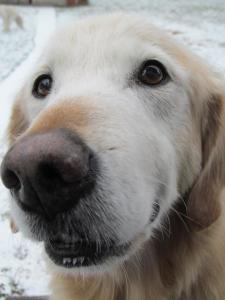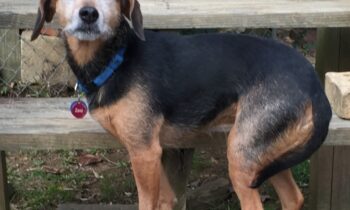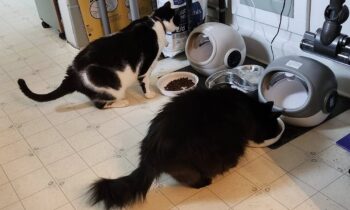
Old dogs. If you are very lucky, some day you will have an old dog of your own. I have two right now, although the little one isn’t considered “elderly” quite yet because her size of dog tends to live longer than bigger dogs. She’s thirteen, at the top end of tiny-dog middle age. My other thirteen-year-old is a golden retriever. He’s definitely considered a senior. He is the oldest dog I’ve ever had.
I’m lucky that both of my “seniors” are aging well. Even without specific health issues, though, they are definitely requiring some care that differs from what they needed in their younger years.
I’ve been thinking about the skills we teach our dogs when they are young and how those skills can help them as they age. I suggest that you look at your young dog today and remember that now is the time to prepare him or her for later life, whatever challenges it might bring.
Crating
As you know if you’ve read this blog before, I believe that the dog crate should be one of the most important items in your dog’s life. I advocate using a crate to transport your dog in the car (it’s the only truly safe way to travel with a pet), to aid in housebreaking (again, it’s the most effective method), and to confine the dog comfortably throughout his life when you are not there to supervise his activities.
In the middle of your dog’s life, you may find little need for a crate except when your dog rides in the car. He’s reliable in the house—no accidents, no destruction, no incidents when you’re gone. Maybe the only time he’s crated at home is when something is happening there—painting, repairs, cleaning—that he might inadvertently interfere with . . . or when you have visitors who are allergic to him.
Don’t put that crate away in a closet!
Keep it always accessible to your dog.
You never know when you’ll need it or he will want to use it.
In later life, he may seek out the comfort of his crate for many reasons. I’ve seen many large dogs who decide that a crate is a much better place to sleep than on the floor (even on a dog bed) because the crate provides more support and comfort to their aging bodies. The crate also offers a steady spot to stand up in, much better than a slippery floor. The dog can get his feet under him and walk out rather than scrabbling and staggering to an upright position on a surface where he has no traction.
Dogs often head to their crates when they are not feeling well.
For you, it’s a way to confine the repercussions of any digestive upset to one easily cleaned-up place, plus you will always know where the dog is when you need to give him medication or check on how he is doing. Loose, he might become disoriented. In the kennel, he’s always in a familiar place—his room, if you will. Recovering from surgery, recovering from an injury? Crate rest is prescribed.

Care from Others
As soon as your dog becomes a family member, I highly recommend that he start learning to accept and welcome care from other humans besides those who live in the same house with him. Start with extended family and friends who will be a part of his daily life—neighbors, too.
First, allow your new family member to interact with that larger circle of humans naturally, by getting to know them on visits and walks. Stop by a neighbor’s house and bring your pup with you. Invite friends to drop in regularly to help socialize your new pet. Arrange for your dog to stay overnight (with his crate) at grandma’s house now and then, and make sure grandma has everything she needs to make the pup’s experience a good one. Eventually, let your well-trained and well-behaved dog go on walks where a friend holds his leash and you walk along beside, giving instruction as needed. Exchange overnights with others who have compatible dogs. Find a great pet-sitter and go away for a weekend.
Never be the “only one” who can care for your dog!
Fido needs a large network of extended family and friends for whom he has a positive regard and with whom he feels safe. You never know when this “training” will be needed. Don’t wait—do it now!
Accepting Assistance
As your dog ages, there will be changes in his abilities. Did he once leap up onto your bed in a single jump? Was he able to climb into your car and dive into his crate at one word from you? Did he run up and down stairs, fly over obstacles, screech around corners at high speed? Are you prepared to deal with him when it’s no longer so easy for him to get around? Train for it now and you will be prepared. What’s even more important? Your dog will be prepared, too.
Lift your dog every day, from the first day he enters your home.
Puppies are easy—it would be highly unlikely that you’d have a puppy you couldn’t pick up. This should be a standard exercise to be practiced until your pup is simply too heavy for you to lift alone. Then practice lifting and carrying him between two people. Your dog is too big for even two people to lift? Find or make a safe way to carry that big dog—a sturdy blanket or a doggy stretcher. Keep that device handy and don’t forget to take it with you when you and the dog are away from home.
Practice regularly so that your dog will learn to accept being carried.
You may never have to use your “dog stretcher” for an emergency, but imagine what you would do without it if an emergency came. Better safe than sorry, I’d say. It could save your big dog’s life.
You can also practice—with any size of dog—physical assists that will aid the dog’s mobility as he ages. One of the most useful and easiest to accomplish is the under-belly towel lift, intended to provide stability for walking to a dog who, for one reason or another, is not “steady on his pins.”
Once your dog is familiar with being dried off with a towel when he comes in from a walk or playing in the yard in the rain, mud, or snow, start by looping the towel under his belly area, with the ends of the towel in your hands. Don’t lift the dog immediately. First let him get used to the feeling of the towel wrapped around him. Give lots of praise and treats, and keep each lesson short and rewarding.
Eventually, you will encourage the dog to walk while you keep a constant “up” pressure on the towel you are holding—not enough to lift him off his paws, just enough to steady him as he walks. While it may seem silly and somewhat pointless right now, remember that as many dogs age, they can no longer negotiate stairs. If stairs are a part of their daily lives, using the towel assist may offer those dogs more freedom at home and easier access to areas they’re accustomed to using.
With the towel assist, your aging dog will still be able to potty in his own yard!
No stairs where you live? That could change, you know! Find stairs and practice on them while your dog is young and healthy.
My thirteen-year-old golden retriever was surprised the other day when, instead of encouraging him to hop up onto my bed—something that’s becoming more difficult for him as he ages—I picked him up and put him there. He had the funniest look on his face! I think he was saying, “Geez, you can still lift me? I thought you were too old.” (That rascal.) I was glad I could still lift him, and I was delighted that he still let me, with as much trust as always. I’m sure we’ll settle on another method before my back gives out, but for now, I know I can do what’s necessary to make my dog comfortable, regardless of his age, because it’s something we’ve practiced since he was young. That’s what life skills are all about!



